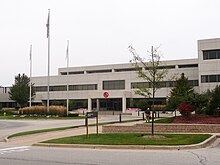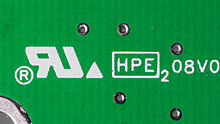Underwriters Laboratories
| Underwriters Laboratories Inc.
|
|
|---|---|
| legal form | Corporation |
| founding | 1894 |
| Seat | Northbrook, Illinois , United States |
| Number of employees | 12,000 (2013) |
| Branch | Testing and certification services |
| Website | www.ul.com |
Underwriters Laboratories ( UL for short ) was founded in 1894 and is an independent organization that examines and certifies products with regard to their safety. The company is headquartered in Northbrook , Illinois . UL International Germany GmbH is based in Neu-Isenburg near Frankfurt and is the headquarters for Europe and Latin America. UL International Germany GmbH is also represented with further branches in Neu-Ulm, Munich, Krefeld, Wilhelmshaven, Bremen and Cologne.
tasks
UL does not "approve" any products. Rather, the organization checks products, components, materials and systems to see whether they meet specific requirements. If this is the case, these products may bear the UL mark, which is subject to a charge, as long as they comply with the specified standards.
UL develops standards and procedures to test products, materials, components, parts, devices, systems and equipment in terms of safety. The system certification activity (e.g. based on the ISO 9001 and ISO 14001 standards ) was merged with the German Society for the Certification of Management Systems ( DQS ) in 2008 . This assessment activity is carried out by DQS worldwide.
UL is one of the few companies that has been approved by the Occupational Safety and Health Administration (OSHA), a federal agency in the United States . OSHA maintains a list of all nationally recognized testing laboratories under the name Nationally Recognized Testing Laboratories .
UL has developed more than 1,300 safety standards, many of which are American National Standards (ANSI) . A typical standard for electrical goods includes not only the requirements for electrical safety, but also a broad spectrum with regard to flammability and mechanical hazards.
history

Underwriters Laboratories Inc. was founded in Chicago in 1894 by William Henry Merrill . The electrical engineer had been sent there from Boston a year earlier to check the Palace of Electricity at the World's Fair. The 25-year-old recognized the growing potential in the area of product safety and stayed in Chicago to found Underwriters Laboratories. Merrill developed standards, started tests, designed the necessary equipment and identified possible sources of danger. In addition to his work at UL, the company's founder was Treasurer (1903–1909) and President (1910–1912) of the National Fire Protection Association and an active member of the Chicago Board and Union Committee . Then in 1916, Merrill became UL's first president.
UL published its first standard in 1903 with the "Tin Clad Fire Doors", the tin-clad fire doors. The following year the UL mark made its debut on a fire extinguisher. In 1905, UL established a marking service for certain product categories that required regular inspections. In addition, the UL inspectors carried out their first operational inspection at a manufacturer who marked its products with the UL symbol. To this day, it is precisely these unannounced on-site inspections that characterize UL's test and certification programs.
Over the years UL has grown into a global organization. The UL experts now provide support in 73 laboratories, test and certification facilities in 104 countries. In addition, UL has significantly expanded its service portfolio. Based on the original areas of fire protection and electrical safety, the company now covers a broad spectrum, which also includes topics such as hazardous substances, water quality and food safety.
Since 2011 there has been a cooperation between Underwriters Laboratories Inc. and the Physikalisch-Technische Bundesanstalt in the field of explosion protection.
Approval marks and certification
UL offers various certifications: The UL listing test mark is the proof that UL has tested representative samples of the corresponding product and confirmed its compliance with the applicable UL safety requirements. The UL-Recognized-Component-Mark indicates that the UL-recognized component can be used in a product or system that bears the UL-Listing mark.
The UL classification mark is on products that UL has assessed with regard to certain properties in order to rule out risks and to confirm the usability under certain conditions. This also includes security features such as B. the labeling of the products. UL maintains a directory of more than 3 million products that are publicly available through online databases.
For the certification of its product by UL, a manufacturer must prove that he complies with the specified safety requirements, most of which were developed by UL itself. At the same time, a manufacturer must use an appropriate system to ensure that every copy of his product also meets the specified security requirements. To ensure that a manufacturer adheres to the specifications in the long term, UL inspects the production facilities at irregular intervals without prior notice. If a manufacturer modifies its product design, UL must first have tested the new version before the product can bear a UL test mark.
In principle, the UL mark has no more legal weight than other trademarks. This is where it differs from CE marking or the Federal Communications Commission Part 15 standard , both of which are required by law. In practice, however, it will be very difficult to bring certain products onto the US market without a UL certification mark. Wholesalers could forego delivering a product without a UL seal of approval. The use of non-certified devices could also lead to a loss of insurance cover. It is therefore common in many areas to list products with the UL listing test mark or materials with the recognized component test mark. There are also references to UL standards in the National Electrical Code (NEC); UL standards are sometimes used as the basis for the further development of the NEC, which means that manufacturers must meet these standards (similar to the German DIN VDE 0100). In addition, building authorities, fire protection officers and inspectors could refuse to approve a product for installation in a building if it does not bear a recognized seal of approval. In the past 20 years there has been great progress in harmonizing international safety standards. Manufacturers can use a single certification process to obtain a certification mark from UL that complies with national standards in both the USA and Canada. Then the test marks have a “C” and a “US” right next to the UL logo.
Web links
Individual evidence
- ↑ UL Locations. Retrieved September 12, 2019 .
- ↑ Current information from PTB on the cooperation agreement between Underwriters Laboratories Inc. (USA) and PTB in the field of explosion protection (accessed March 18, 2014).
- ↑ What is the UL certification? Hein Industrieschilder GmbH's blog post on UL labeling (accessed March 18, 2014).
- ^ Online Certifications Directory product database from UL, English (accessed March 18, 2014).



